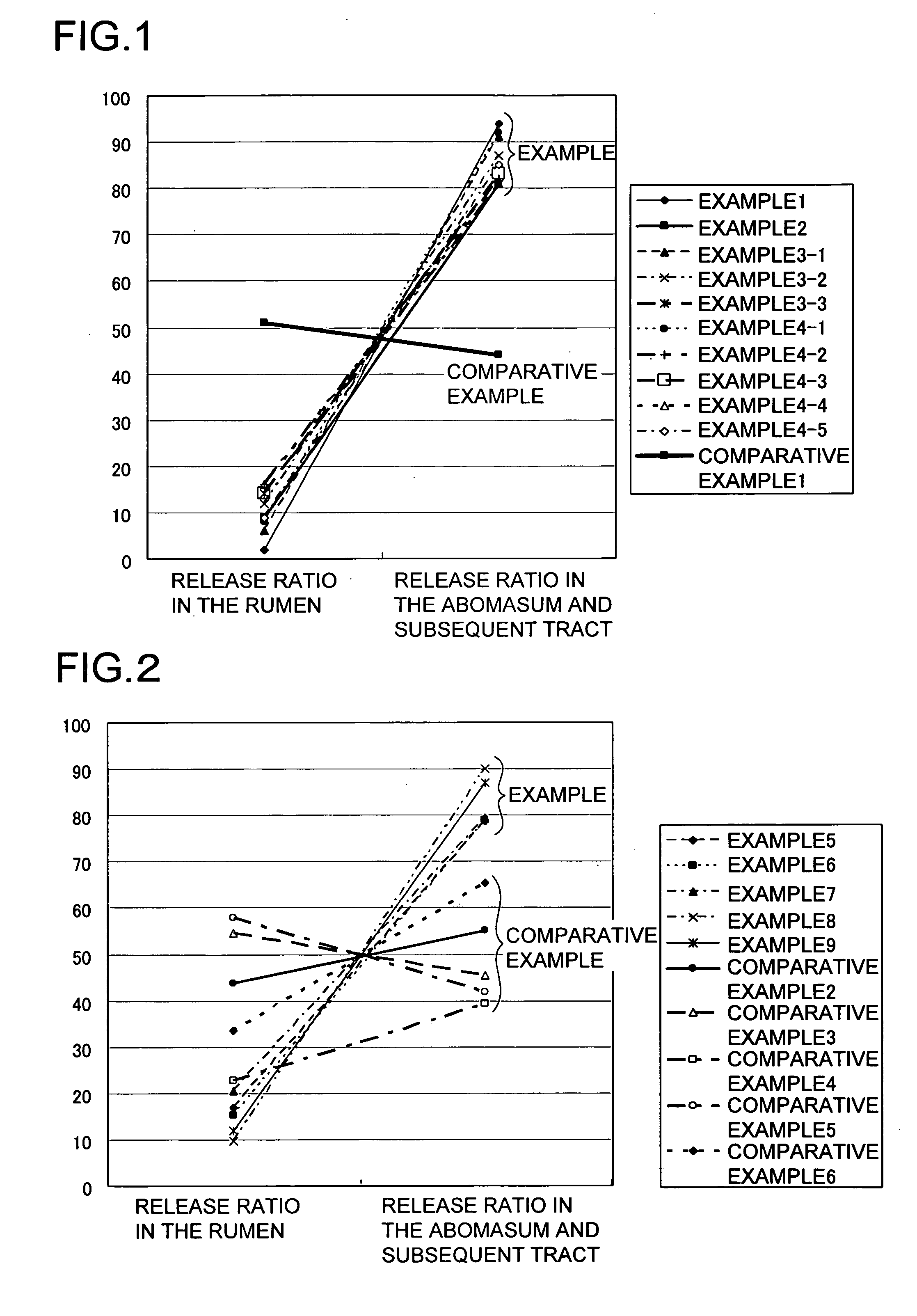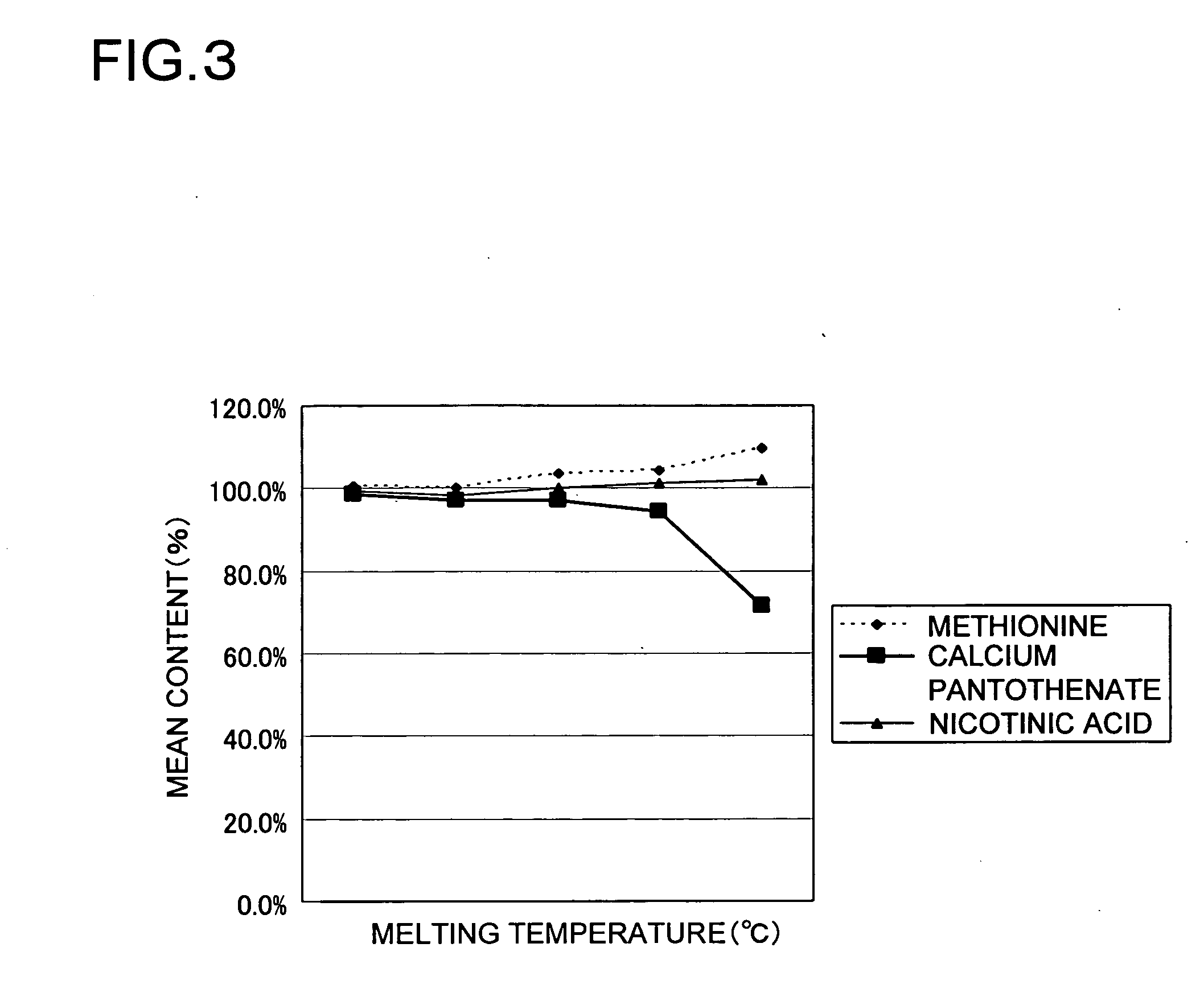Feed additive composition for ruminants, and feed containing the same, and method of fabricating such feed additive composition for ruminants
a technology of additive composition and rumen, which is applied in the field of feed containing the same, and the method of fabricating such feed additive composition for ruminants, can solve the problems of high manufacturing cost, insufficient rumen bypass effect, and fabrication process, and achieve excellent rumen bypass product, low cost, and good rumen bypass effect.
- Summary
- Abstract
- Description
- Claims
- Application Information
AI Technical Summary
Benefits of technology
Problems solved by technology
Method used
Image
Examples
example 1
[0060] While various examples shall be enumerated below with a detailed description, the present invention is, in no way, limited to such examples.
(Preparation of the Rumen Bypass Product)
[0061] A melt liquid of coating composition was prepared, first by measuring 1200 g of methionine, 1650 g of hardened rapeseed oil, 50 g of lecithin, 70 g of stearic acid, and 30 g of palmitic acid, and then by heating a mixture of hardened rapeseed oil, lecithin, and stearic acid at 85° C. The methionine was uniformly blended and dispersed in such melt liquid of coating composition to produce an injection melt liquid being kept warmed at 85° C. The injection melt liquid was injected into air to obtain a rumen bypass product solidified into a spherical form of 0.1 to 3 mm diameter. The rumen bypass product was assayed in the following method.
(Evaluation of Protective Ability in the Rumen)
[0062] The rumen bypass product was immersed in McDougall's buffer corresponding to the ruminal fluid, and...
example 2
[0066] Next, another rumen bypass product is prepared in accordance with Example 2 of the present invention. A melt liquid of coating composition was prepared, first by measuring 1200 g of lysine hydrochloride, 1300 g of hardened rapeseed oil, 30 g of lecithin, and 470 g of stearic acid, and then by melting the hardened rapeseed oil, followed by adding the lecithin and the stearic acid to be kept warmed at 80° C. The lysine hydrochloride was uniformly blended and dispersed in such melt liquid of coating composition to produce an injection melt liquid being kept warmed at 80° C. The injection melt liquid was injected into air to obtain a rumen bypass product solidified into a spherical form of 0.1 to 3 mm diameter. The rumen bypass product in Example 2 was assayed in the same method as was employed in Example 1. The evaluation result is illustrated in Table 1.
example 3
[0067] Yet another rumen bypass product was prepared in accordance with Example 3 of the present invention. A melt liquid of coating composition was prepared, first by measuring 150 g of lysine hydrochloride, 400 g of methionine, 10 g of vitamin B1, 1750 g of hardened rapeseed oil, 300 g of hardened palm oil, 90 g of lecithin, and 300 g of stearic acid, and then by melting the hardened rapeseed oil and the hardened palm oil, followed by adding the lecithin and the stearic acid to be kept warmed at 75° C. The lysine hydrochloride, the methionine, and the vitamin B1 were uniformly blended and dispersed in such melt liquid of coating composition to produce an injection melt liquid being kept warmed at 75° C. The injection melt liquid was injected into air to obtain a rumen bypass product solidified into a spherical form of 0.1 to 3 mm diameter. The rumen bypass product in Example 3 was assayed in the same method as was employed in Example 1. The evaluation result is likewise illustrate...
PUM
| Property | Measurement | Unit |
|---|---|---|
| Temperature | aaaaa | aaaaa |
| Percent by mass | aaaaa | aaaaa |
| Percent by mass | aaaaa | aaaaa |
Abstract
Description
Claims
Application Information
 Login to View More
Login to View More - R&D
- Intellectual Property
- Life Sciences
- Materials
- Tech Scout
- Unparalleled Data Quality
- Higher Quality Content
- 60% Fewer Hallucinations
Browse by: Latest US Patents, China's latest patents, Technical Efficacy Thesaurus, Application Domain, Technology Topic, Popular Technical Reports.
© 2025 PatSnap. All rights reserved.Legal|Privacy policy|Modern Slavery Act Transparency Statement|Sitemap|About US| Contact US: help@patsnap.com


